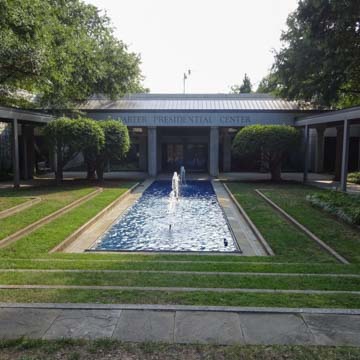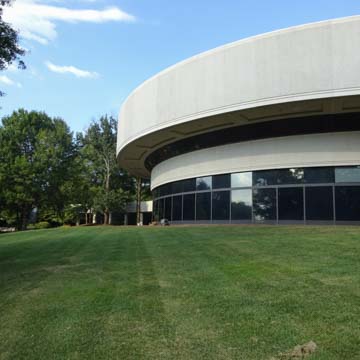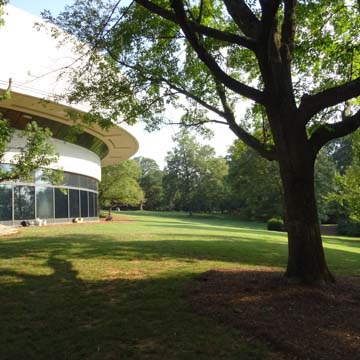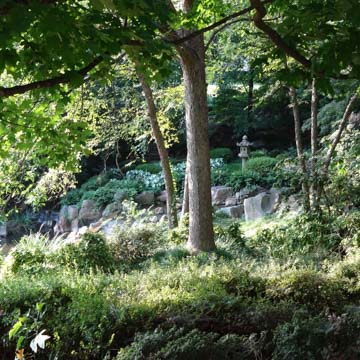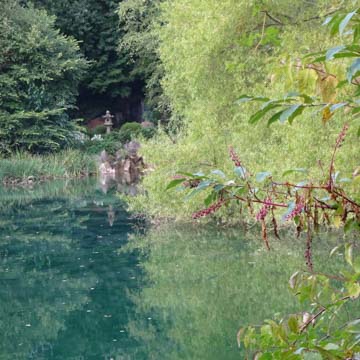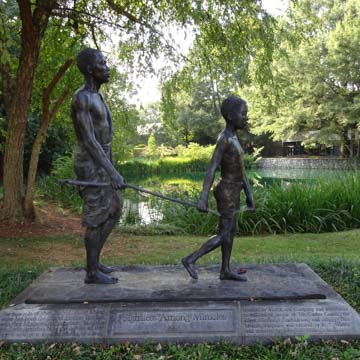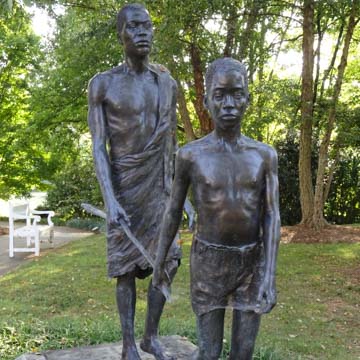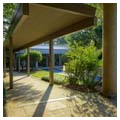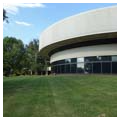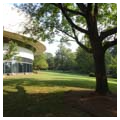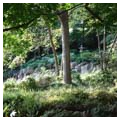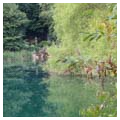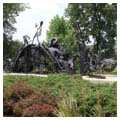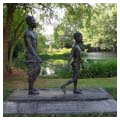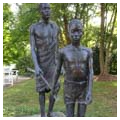Designed as a crescent of circular drums and constructed in concrete, steel, and glass in forms nestled into the buildings’ hillside site two miles east of downtown Atlanta, the circular pods of the Jimmy Carter Presidential Library and Museum and Carter Center fulfilled Carter’s requirement that the architecture must utilize the circle as a symbol of unity, reflecting the former president’s worldview. Architectural firm Jova/Daniels/Busby (JDB) designed the buildings as models of sustainability in contextual harmony with the natural landscape, producing a successful complex of round buildings that has been the center of Carter’s post-presidency.
Visitors enter the library from the east, noting a circular rondel of international flags—the first symbol of unity. Rather than a large and intrusive parking lot, there are several smaller parking areas tucked within copses adjacent to hill slopes and sheltered by the many preserved trees on the property. A covered, stepped walkway flanking a rectangular pond with water jets leads to the building’s lobby that serves both the library to the south and the Carter Center (which houses the non-for-profit organization of the same name) to the north. Straight ahead is a glass wall with a magnificent view of the Atlanta downtown and midtown skyline, and an exit to the grounds on the west side. Following a winding path a short distance from the building one finds R. T. Wallen’s sculpture, Sightless Among Miracles, a 1995 bronze that celebrates the Carter Center’s efforts to eradicate river blindness in Africa and Latin America. A few more paces westward and one can turn back and view the architecture to its best advantage. Displaying broad overhangs, the circular white pavilions are nestled into the hillside, kept low with a substantial portion of the buildings underground. With this design, the architects fulfilled another intention of the project: that it be sensitively integrated with the immediate natural environment. Carter insisted that no trees be removed from the site, and much credit goes to the landscape architecture firm, EDAW, who preserved wood copses and aged great oaks. A Japanese garden by Kinsaku Nakane offers repose when viewed from a hillside path or from inside the Carter Center.
In the grouping of white drums, the southernmost pod houses the Carter museum, library, and mostly underground archive, a repository of 27 million papers and documents, 1.5 million photographs, and 40,000 objects. Three joined pods house the Carter Center, with a fourth planned in the original concept and added later, built to contain a nondenominational chapel cum conference room with seating for up to 400. The presidential pod contains the president’s office, Rosalynn Carter’s office, and a presidential suite in which the Carters live when they visit Atlanta, including space for the Secret Service downstairs. Other pods contain space for the administration of the Carter Center, conference and meeting rooms, and office suites for visiting scholars, researchers, and their assistants.
Planning for the project began in 1981 on a hilltop site overlooking the downtown skyline, at the center of the no longer extant Copenhill residential neighborhood. Of the four Atlanta architecture firms invited to submit proposals, JDB was ultimately selected to work in collaboration with Hawaiian firm Lawton, Umemura and Yamamoto, which had been suggested to the Carters by Chris Hemmeter, a hotel developer of their acquaintance from Hawaii. Carter had worked with JDB on two prior occasions, for a master plan of the Capitol Hill area toward the end of Carter’s gubernatorial term, and for an interior renovation in the Richard Russell Building following Carter’s presidency. Construction on the library complex was completed in 1984, and the last pod added in 1989–1991.
The project was controversial from the start not only because of Carter’s joining a public presidential library to the private Carter Center enterprise, but also because of efforts to revive an eight-lane expressway project that had been opposed by Atlantans for years. Ironically, in 1970, then governor Carter had ended the project that would have built a highway from Atlanta to nearby Stone Mountain. Plans were revived, however, during planning stages for the presidential library. The expressway was planned to run through the city’s inner neighborhoods, including Druid Hills, Frederick Law Olmsted’s last major project, and around Carter’s library complex toward downtown. Due to citizen opposition, today only a part of the expressway (from downtown to the Carter Center) was completed. The remainder of the right-of-way comprises a much reduced parkway and public park. Despite the controversy, the Carter Center and Presidential Library in Atlanta is a landmark of national and international significance, documenting the presidency of Georgia’s native son, and the centerpiece of one of the most remarkable post-presidencies to date.
References
Applebome, Peter. “Carter Center: More Than the Past.” New York Times, May 30, 1993.
Daniels, Stanley. Interview by Rebecca Duncan, April 8, 2011, Atlanta, Georgia.














